network layer
- primary role: to move packets from a send host to a receiving host
two key functions
-
forwarding: move packets from router’s input to appropriate router output
-
routing: determine route taken by packets from source to destination
- routing algorithms
data plane & control plane
data plane
-
determine how datagram arriving on router input port is forwarded to router output port
-
local, per-router function
-
forwarding function
control plane
-
determine how datagram is routed among routers along end-end path from source host to destination host
-
network-wide logic
-
two approaches:
-
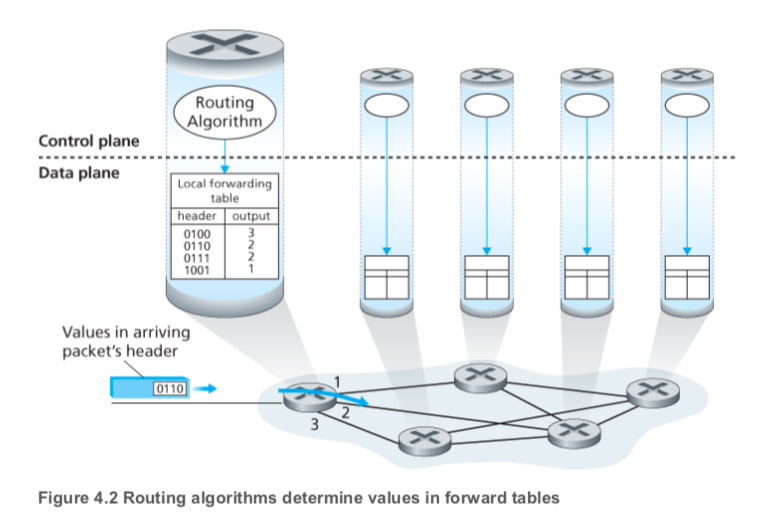
-
traditional routing algorighms - implemented in routers
-
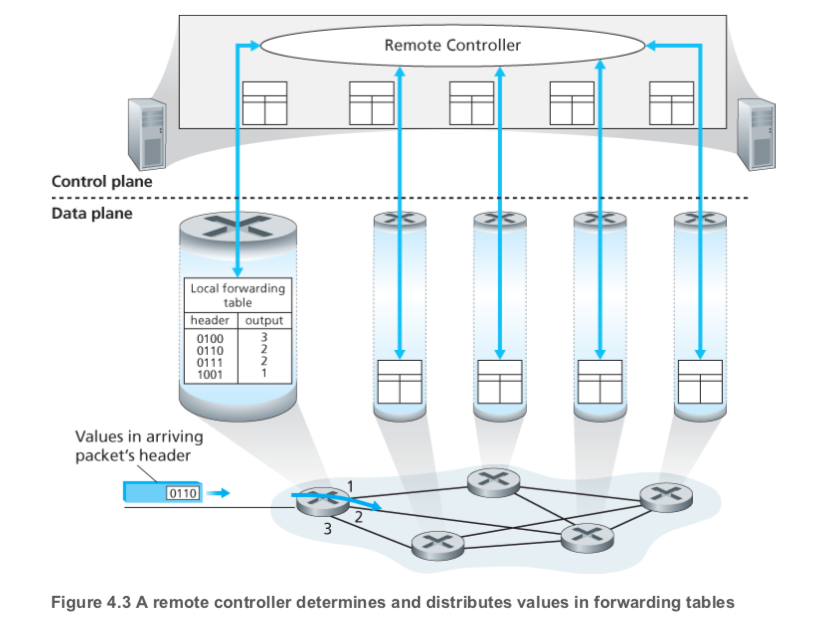
-
SDN - implemented in (remote) servers
-
What’s inside a Router
input port processing
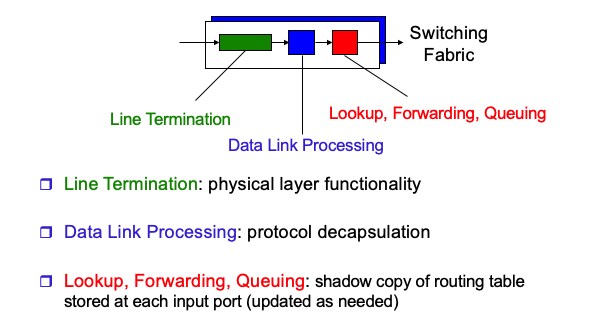
-
destination-based forwarding
-
forwarding table
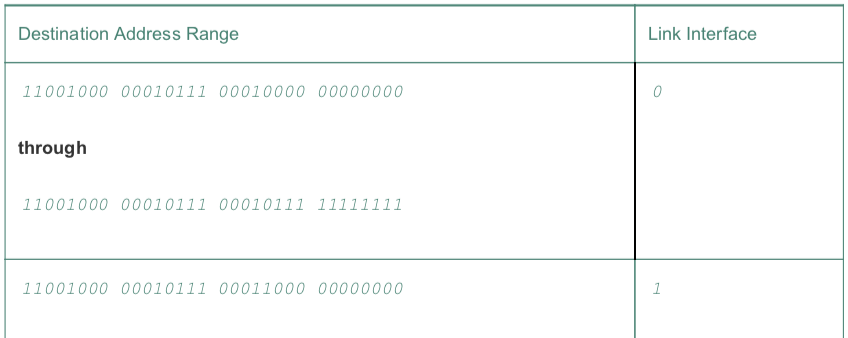
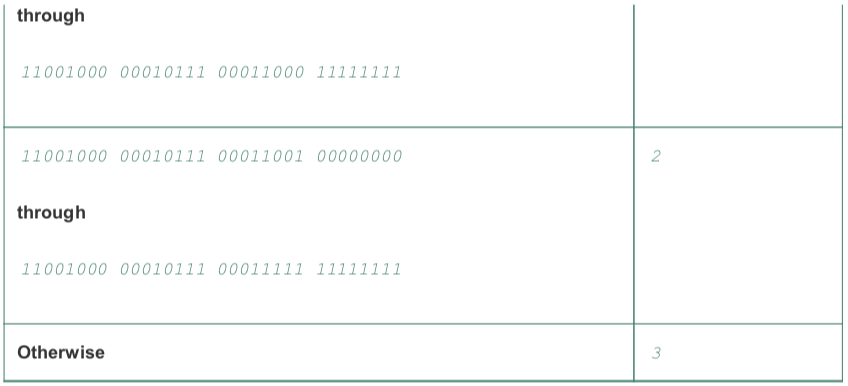
- the
destination address rangecan be write asprefix

- When an input packet arrives, it need to be matched the address in forwaring table. If there are multiple matches, the router uses the longest prefix matching rule:
- it finds the longest matching entry in the table and forwards the packet to the link interface associated with the longest prefix match
Switching
-
Through the switching fabric, the packets are switched from an input port to an output port
-
switching can be accomplished by several ways:
-
via memory
-
simplest
-
uder direct control of CPU
-
-
via bus
-
use shared bus
-
routing processor not used
-
protential blocking
-
-
via corssbar (interconnection)
-
higher BW possible (no blocking)
-
more expensive
-
-
Output port processing
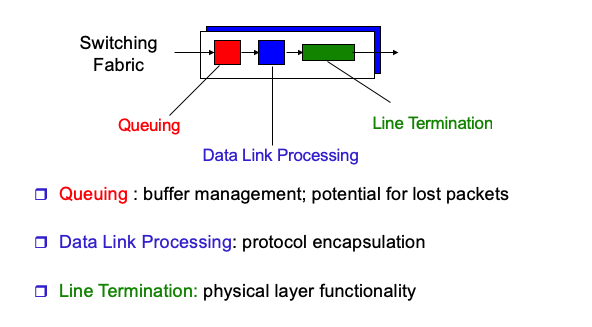
CIDR
-
Classless Interdomain Routing
-
used to generalize the notion of subnet addressing (like the scope of the IP address in a organization)
-
32-bit IP address is divided into two parts and has the form
a.b.c.d/x, where x indicates the number of bits in the first part of the address -
Example: the ISP may itself have benn allocated the address block
200.23.16.0/20, then it divides its address block into eight equal-sized contiguous address blocks and give one of these address blocks out to each of up to eight organizations that are supported by this ISP, as shown below:ISP’s block: 200.23.16.0/20 11001000 00010111 00010000 00000000 Organization 0 200.23.16.0/23 11001000 00010111 00010000 00000000 Organization 1 200.23.18.0/23 11001000 00010111 00010010 00000000 Organization 2 200.23.20.0/23 11001000 00010111 00010100 00000000 ... ... ... Organization 7 200.23.30.0/23 11001000 00010111 00011110 00000000
DHCP
-
Dynamic Host Configuration Protocol
-
dynamically get address: plug-and-play
-
host broadcasts
DHCP discovermsg -
DHCP server responds with
DHCP offermsg -
host request IP address:
DHCP requestmsg -
DHCP server sends address:
DHCP ackmsg
-
-
DHCP use UDP, because the host has no idea with DHCP server’s IP address at beginner, so it broadcast the DHCP discover msg. TCP doesn’t support broadcast.
get a datagram from source to dest
-
from A (223.1.1.1) to B (223.1.1.2): send datagram directly from A to B
-
from A (223.1.1.1) to C (223.1.2.2): send from A via 223.1.1.4 (gateway) and 223.1.2.9 (gateway) to B
IP Fragmentation & reassembly
-
reason: link layer have MTU (max transfer size), different link types, different MTUs
-
large IP datagram divided into small
-
reassembleed only at final destination
-
e.g: datasize is 4000 ( data 3980 + header 20), MTU is 1500. we can divide it to 3 part
-
length = 1500 (data 1480 + header 20), offset = 0, fragflag = 1
-
length = 1500 (data 1480 + header 20), offset = 1480, fragflag = 1
-
length = 1040 (data 1020 + header 20), offset = 2960, fragflag = 0
-
IPv6
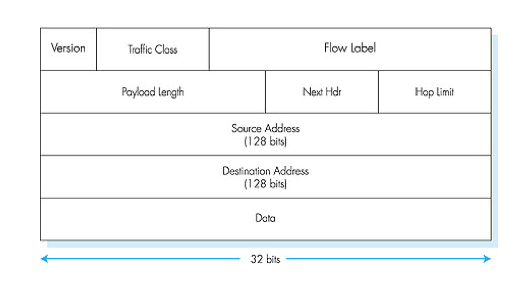
-
have this new:
-
Expanded addresseing capability: from 32 to 128 bits
-
A streamlined 40-byte header
-
Flow labeling
-
-
no longer have:
-
Fragmentation / reassembly
-
Header checksum
-
Options
-
-
Transitioning from IPv4 to IPv6
- use tunneling: Suppose two IPv6 nodes (B and E) want to interoperate using IPv6 datagrams but are connected to each other by intervening IPv4 routers. We refer to the intervening set of IPv4 routers between two IPv6 routers as a tunnel. Here is the prccedure:
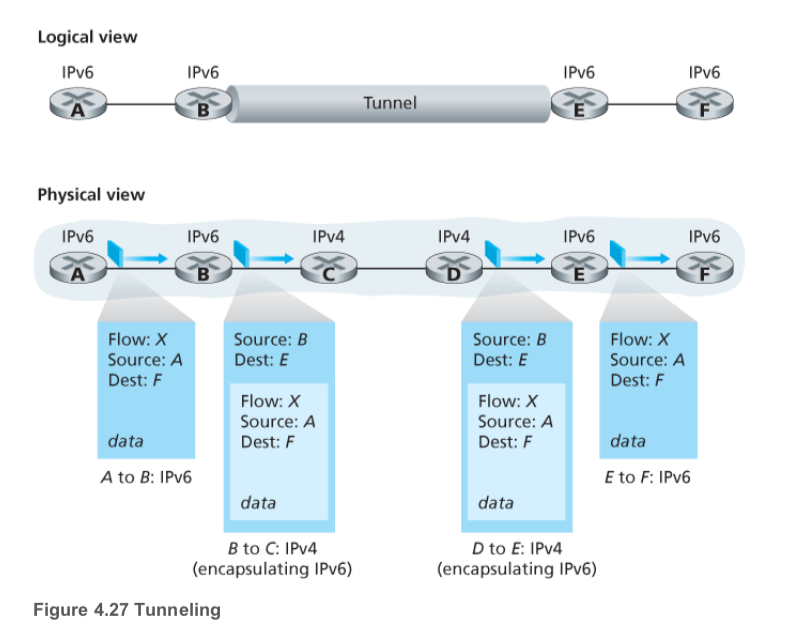
OpenFlow
-
match-action table
-
Match
- for this exam, we mainly use
Ingress port = 1,IP Src = 10.1.*.*,IP Dst = 10.2.*.*
- for this exam, we mainly use

-
Action
-
Forwarding: to output port
-
Dropping
-
Modify-field
-
routing algorighm
link-state
-
use global info
-
dijkstra
Initialization:
N’ = {u}
for all nodes v
if v is a neighbor of u
then D(v) = c(u, v)
else D(v) = ∞
Loop
find w not in N’ such that D(w) is a minimum
add w to N’
update D(v) for each neighbor v of w and not in N’:
D(v) = min(D(v), D(w)+ c(w, v) )
/* new cost to v is either old cost to v or known
least path cost to w plus cost from w to v */
until N’= N
distance vevtor
-
iterative, asynchronous, and distributed
-
Bellman Ford
- Dx(y) = minv{c(x, v) + Dv(y)} (v is the neighbor of x)
Initialization:
for all destinations y in N:
Dx(y)= c(x, y)/* if y is not a neighbor then c(x, y)= ∞ */
for each neighbor w
Dw(y) = ? for all destinations y in N
for each neighbor w
send distance vector Dx = [Dx(y): y in N] to w
loop
wait (until I see a link cost change to some neighbor w or
until I receive a distance vector from some neighbor w)
for each y in N:
Dx(y) = minv{c(x, v) + Dv(y)}
if Dx(y) changed for any destination y
send distance vector Dx = [Dx(y): y in N] to all neighbors 18
forever
compare
| Algorithm | message complexity | speed | robustness (if one node fault) |
|---|---|---|---|
| LS | O(nE) msgs sent each | O(n^2) | each node compute only its own table |
| DV | exchange between neighbors | varies (from O(n) to infinity) | each node uses other’s data |
Scalable routing
-
aggregate routers into regions known as
autonomous system(AS) -
why AS: scale and administrative autonomy
-
intra-AS routing
-
routing among hosts, routers in same AS
-
all routers in AS must run same intra-domain routing protocol
-
routers in different AS can run different intra-domain routing protocol
-
gateway router: at edge of its own AS, has link to routers in other AS
-
-
inter-AS routing
-
routing among AS
-
gateways perform inter-domain routing
-
Inter-AS task
- suppose router in AS1 receives datagram destined outside of AS1, AS1 should:
-
learn which dests are reachable through AS2, which through AS3, …
-
propagate this reachability info to all routers in AS1
-
Intra-AS Routing
-
also known as interior gateway protocols (IGP)
-
most common intra-AS routing protocols:
-
RIPRouting Information Protocol -
OSPFOpen Shortest Path First -
IGRPInterior Gateway Routing Protocol
-
OSPF (Open Shortest Path First)
-
open : publicly available
-
use link-state algorithm
-
router floods OSPF link-state advertisement to all other routers in entire AS
-
carried in OSPF message directly over IP (rather than TCP or UDP)
-
link state: for each attached link
-
-
IS-IS routing protocol is nearly identical to OSPF
-
pros
-
security: exchanges between OSPF routers are authenticated
-
multiple same-cost paths allowed
-
integrated support for unicast and multi-cast routing
- multi-cast OSPF use same topology data base as OSPF
-
hierarchical OSPF in large domins
-
Hierarchical OSPF

-
two-level hierarchy: local area, backbone
-
link-state advertisements only in area
-
each nodes has detailed area topology; only know the direction (shorest path) to other areas
-
-
area border router: “summarize” distance to nets in own area, advertise to other area border router
-
backbone router: run OSPF routing limited to backbone
-
boundary router: connect to other AS
inter-AS routing
-
BGP (Border Gateway Protocol)
-
BGP provides each router:
-
obtain prefix reachability information from neighboring ASs (eg. AS2, AS3, X; AS3, X)
-
determine the “best” routes to the prefixes.
-
-
BGP provides each AS a means to:
-
eBGP (external BGP): obtain subnet reachability information from neighboring ASes
-
iBGP (internal BGP): propagate reachability information to all AS-internal routers
-
determine “good” routes to other networks based on reachability information and policy
-
-
allow subnet to advertise its existence to rest of Internet
-
BGP connection attributes:
-
AS-PATH
-
NEXT-HOP
-
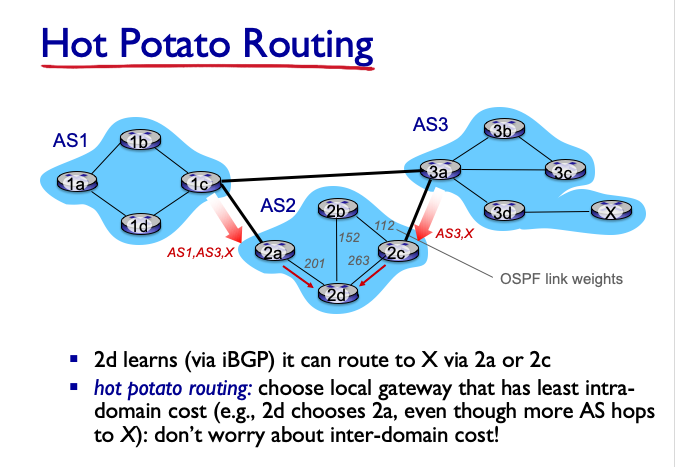
- practice use: Hot Potato routing
BGP route selection priority (from 1 to 4)
-
local preference value attribute: policy decision
-
shortest AS-PATH
-
closest NEXT-HOP router: hot potato routing
-
additional criteria
Different: intra-, inter-AS routing
-
policy
-
inter-AS: admin wants control over how its traffic routed, who routes through its net
-
intra-AS: single admin, no policy need
-
-
scale
- hierarchical routing saves table size, reduced update traffic
-
performance
-
intra-AS: can focus on performance
-
inter-AS: policy may dominate over performance
-
SDN
-
software defined networking
-
ICMP
-
Internet Control Message protocol
-
used by hosts, routers, gageways to communication network-level information
-
error reporting
-
echo request/reply (used by ping)
-
-
ICMP msgs are carried in IP datagram
-
Field
-
type
-
code
-
also contain the header the first 8 bytes of the IP datagram that caused the ICMP message to be generated
-
SNMP
-
Simple Network Management Protocol
-
is an application-layer protocol used to convey network-management control and information messasge between a managing server and an agent executing on behalf of that managing server
-
usage
- In a request-response mode, an SNMP managing server sends a requeset to an SNMP agent, who receives the request, performs some action, and sends a reply to the request
Multicast
-
In 1995, the first multicast network: MBone
-
DVMRP (Distance Vector Multicast Routing Protocol) can’t scale to Internet size
-
In 1997, PIM (Protocol Independent Multicast)
-
Unicast
-
one sender and one receiver
-
concern about where the packet is going
-
-
Multicast
-
one or more senders to a group of receivers
-
concern about where the packet came from
-
Multicast Routing uses Reverse Path Forwarding
-
application: Interactive gaming; shared data apps
-
-
Multicast group is a single identifier that represents a group of receivers
-
IGMP (Internet Group Management Protocol) operates between a host and its directly attached router
Network Security
What is network security
-
Secrecy: only sender, intended receiver should understand msg contents
-
sender encrypts msg
-
receiver decrypts msg
-
-
Authentication: sender, receiver want to confirm identity of each other
-
Message Integrity: sender receiver want to ensure message not altered
Packet sniffing
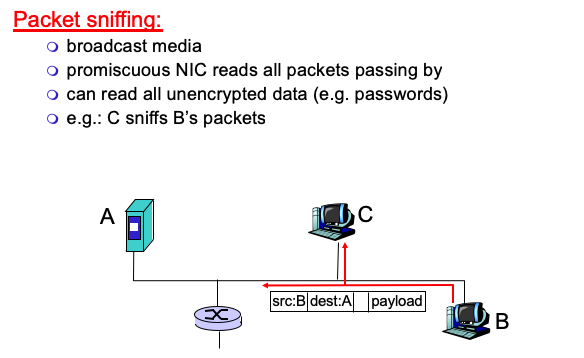
- How sniffing works: Sniffing programs turn off the filter of link layer, and thus see everyones’ traffic address
IP Spoofing
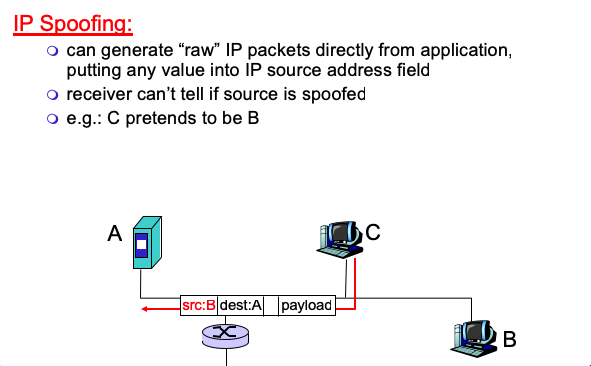
Denial of service (DOS)
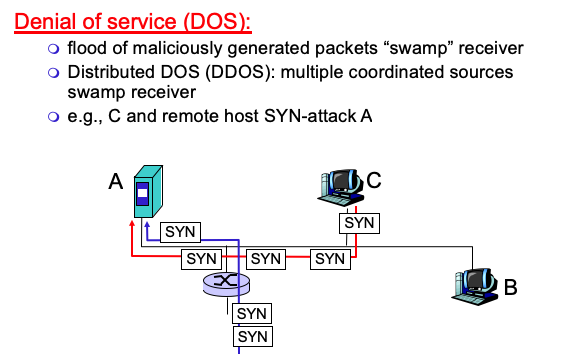
Block Cipher
-
technique of symmetric encryption
-
used in PGP (for secure e-mail), SSL (for securing TCP connection), and IPsec (for securing the network-layer transport)
-
the message to be encrypted is processed in blocks of k bits. For example, if k=64, then the message is broken into 64-bit blocks, and each block is encrypted independently
-
example
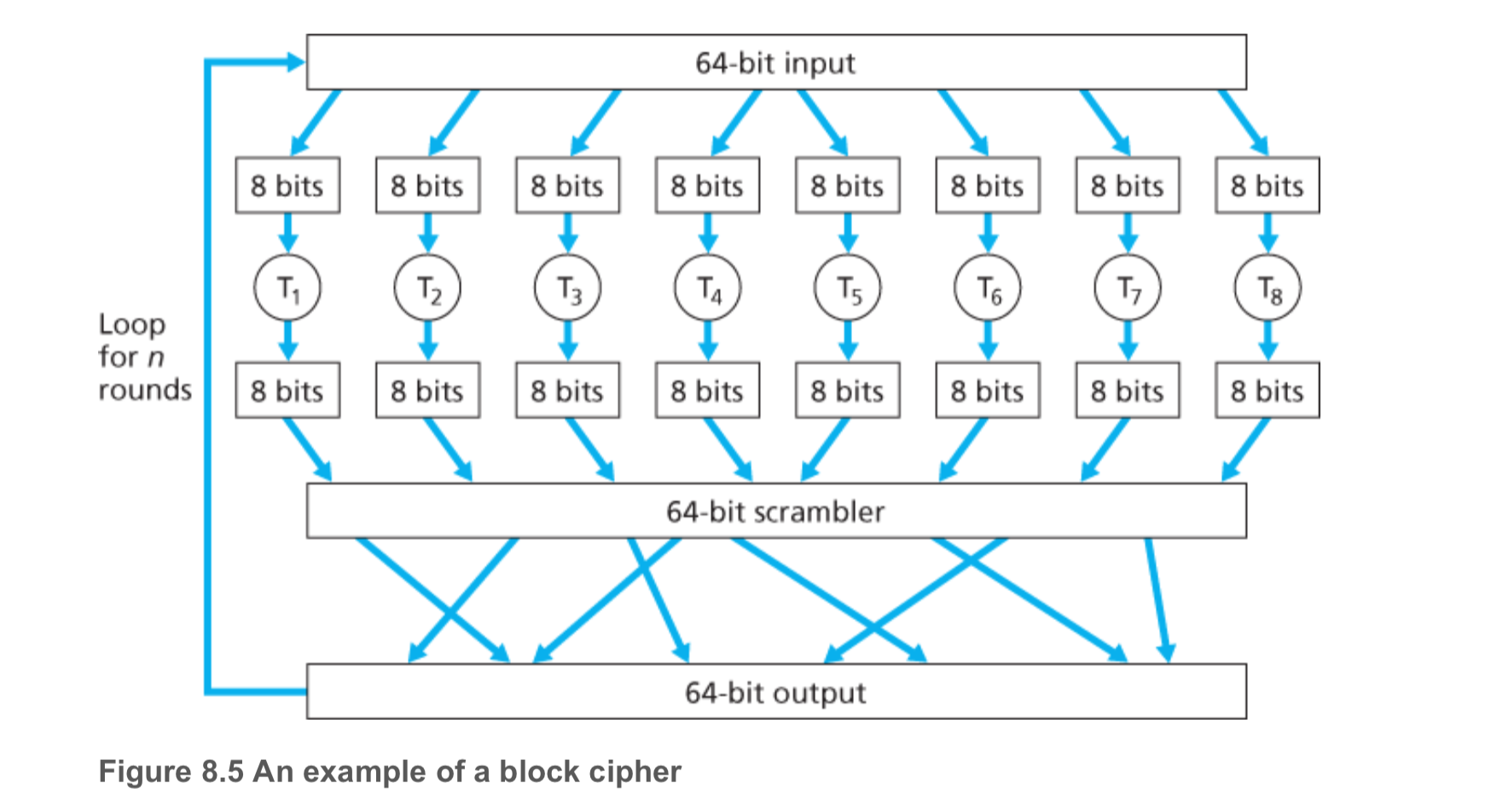
Pretty good privacy (PGP)
-
Internet e-mail encryption scheme
-
use
symmetric key cryptography,public key cryptography,hash function, anddigital signature -
A PGP signed message
---BEGIN PGP SIGNED MESSAGE---
Hash: SHA1
Bob:My husband is out of town tonight.Passionately yours, Alice
---BEGIN PGP SIGNATURE---
Version: PGP 5.0
Charset: noconv
yhHJRHhGJGhgg/12EpJ+lo8gE4vB3mqJhFEvZP9t6n7G6m5Gw2
---END PGP SIGNATURE---
-
How can Bob know that the PGP message is send by Alice rather than Trudy?
-
Alice encrypts the message digest
H(m)with herprivate key (KA-), and sendsKA-(H(m))as a PGP message -
Bob receives the message and decrypts the signature using Alice’s
public key (KA+)and calcutes the message digestKA+(KA-(H(m))) -
If both the results are same, that is
KA+(KA-(H(m))) = H(m), then Bob knows that the message is created and sent by Alice
-
-
PGP does not use a message authentication code (MAC) for message integrity. It uses digital signatures.
Secure sockets layer (SSL)
- works at transport layer. Provides security to any TCP-based app using SSL services
IPsec
-
for Networ- Layer Security
-
authentication header (AH) protocol
- provide source host authentication , data integrity, but not secrecy
-
encapsulation security payload (ESP) protocol
- provide secrecy, host authentication, data integrity
Multimedia
- Service model
-
Uninterrupted
-
Fast approaching real time
-
without error
-
controllable
-
Streaming
-
stored audio, video (eg, Youtube)
-
conversational voice/video over IP
-
using HTTP (why not UDP: UDP sends at a available rate; no data checking)
Recovery from packet loss
-
FEC (forward error correction): add redundant chunk
-
Interleaving: divide audio data into smaller units
RTP (Real Time Protocol)
-
Provides standard packet format for real-time application
-
runs over UDP
Suppose you walk into a room, connect to Ethernet, and want to download a Web page. What are all the protocol steps that take place, starting from powering on your PC to getting the Web pageSuppose you walk into a room, connect to Ethernet, and want to download a Web
-
Connect the PC to network using Ethernet cable
-
Using
DHCPthe PC obtains its IP address -
PC use
ARP protocolto obtain MAC address of first-hop routers and the local DNS server -
PC get the IP address of the web page using
DNS protocolfrom the local DNS server -
PC creates the TCP socket, then prepares to perform a three-way handshake
-
PC build a
TCP SYNsegment, which will be put into anIP packets, finally intoEthernet frames. PC send it to the first-hop router. -
When first-hop router receives the frams, it passes the frames up the IP layer and check its routing table. The router then sends the packets to the right interface out of all of its interfaces.
-
The IP packets are then routed through the internet until they reach the server.
-
The server receives the
TCP SYNsegment, a connection socket is created for the TCP connection between the server and PC. Server then return aTCP SYNACKsegment back to PC. -
When PC receives the TCP SYNACK segment, it performs a
HTTP GETmessage to the server -
The server reads the HTTP GET message, creates
HTTP responsemessage which contains the web page, and returns it to PC -
Finally, PC receives the HTTP response message, the browser display the web page

Comments powered by Talkyard.